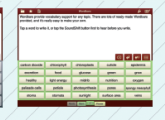With interactive whiteboards or projectors in most classrooms, PowerPoint is a staple of many lessons. We love them because we can pre-prepare them to help us both with the structure and content of our teaching. But for those pupils who sit through several lessons in a row seeing the same format time and time again, it can be monotonous. So why not mix things up a bit? There are some innovative and free alternatives to PowerPoint available online, which might just be the perfect tool for the topic you are teaching. You will have to set up an account, but as they are web-based, you can access them from anywhere – as can those pupils who want to see them again.
1. Prezi (prezi.com)
As a slick and engaging presentation tool, Prezi is a winner. It starts with one large image (or blank space) and allows you to move around, zooming in and out to get to different ‘slides’. It is different enough that it appeals to students, but it is easy to get the hang of creating something engaging. It’s simple to insert pictures (Google Images is accessed within the software) and add sound and videos that play directly, without having to use hyperlinks. The dynamic element makes it ideal for mapping out concepts, either geographically or historically, and for highlighting how key ideas link to each other to create a bigger picture. In physics, lessons on space could zoom in on different planets around the solar system, while geography lessons on the water cycle can look at each stage and zoom out to show how it all fits together.
2. Haiku Deck (haikudeck.com)
A streamlined and simple piece of software, Haiku Deck allows you to search for images under the Creative Commons licence, or upload your own photos, to use as the background for each slide. This is particularly good for highlighting real world examples of the concepts being studied (photos showing different types of angles in maths, for example), or allowing pupils to use their own images, especially if they have access to cameras during lessons. You can add a small amount of text (in one of six fonts) to create clear visual aids for teaching.
3. Powtoon (powtoon.com)
This is an exciting piece of software that can help pupils to see information in a narrative. Rather than static slides of information, Powtoon is an animation that can include text. There are a variety of different styles to choose from, and each one contains characters, props, image holders, shapes and transitions to drag and drop onto a slide, creating a short movie. It is more complex to create a Powtoon compared to the other software looked at here, but the impact is huge as even the simplest animation can engage a pupil’s attention. It would work in English to retell key scenes from Hamlet, for example, or to explain how research methods work in sociology.
4. Google Presentation (docs.google.com)
With an emphasis on collaboration, Google Presentation is ideal for projects requiring different pupils to work together. Part of Google+, it is very similar to PowerPoint, although slightly simpler to use as there are fewer style choices. It is also cloud based, meaning that different contributors don’t need to be in the same location, perfect for pupils to use when creating a group presentation for homework.
5. Good PowerPoint
For many of us, PowerPoint is a familiar tool and so easy to use that the best ‘alternative’ is to simply use it better. ‘Death By PowerPoint’ occurs most often when we use it during an exposition, but there is one very easy way to avoid this: choose images instead of words. It is important to limit the number of words on a slide – no more than six works well – so that we resist the temptation to read them out. Pupils can read the words on the PowerPoint much faster (around 250 words per minute) than we can say them (approx 140 per minute) meaning they read rather than listen. Using cartoon images or photographs that emphasise aspects of what you are saying will also help learners to apply or interpret ideas, for example using pictures of different social movements when teaching social influences in psychology.
About the Author
Philippa Seago has ten years’ experience of teaching Psychology and RE. Currently, she is Teacher in Charge of Psychology at an Outstanding community school in Littleover, Derby. She is also a blogger and author.










